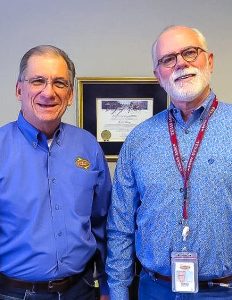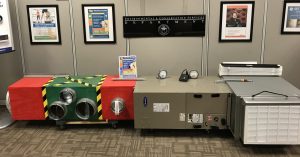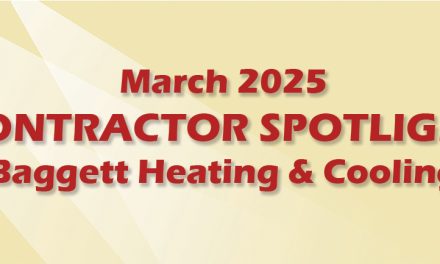Austin Energy: Yesterday, Today, and Tomorrow
This month we shine our spotlight on a different entity in the HVAC universe. Our focus is on a publicly-owned utility – Austin Energy ‘ that serves the city of Austin, TX and surrounding areas. Austin Energy (AE) was first established in 1895 and today is the eighth largest public utility in the U.S.
Why this focus on a public utility?
First, for the past 40 years, Austin Energy has operated energy efficiency programs for customers. They are one of the first utilities to do so. The program includes a contracting group that offers an ‘energy audit’ to identify ways customers can reduce energy use. Austin Energy also provides rebates of up to 20% of the cost of improvements.

Tom Turner (left) is the Environmental Program Coordinator for Field Services and Terry Moore, the Residential Energy Conservation Manager for Austin Energy.
According to Terry Moore, Residential Conservation Energy Manager, the utility has a portfolio of energy efficiency programs spanning three markets: residential, multi-family, and commercial.
‘My focus is the residential world,’ he explains. ‘Our foundational program in residential is Home Performance with Energy Star. That program addresses the needs of the entire home rather than piecemeal enhancements.’
He adds that the Home Performance program assists roughly 1,000 homes a year.
‘Austin Energy also has a ‘Weatherization Assistance Program’ that assists qualifying low income rate payers with improvements that mirror the ‘Home Performance Program?. This program reaches between 850-900 homes a year
Says, Moore, ‘What’s unique about our Weatherization program is that it’s evolved beyond the traditional weatherization model of weather-stripping doors and windows, adding attic insulation, patching holes, repairing windows, leaks, and plumbing, to taking a whole house approach.
‘We have really dialed into energy efficiency improvements. That means our low-income customers who may not be able to go through Home Performance with Energy Star Program can still get many of those benefits from within our Weatherization program.’
The ‘Weatherization Assistance Program’ covers up to $7,500 in cost to qualifying customers with an average cost in the program of $3,500 per home. Moore says home performance results in savings of around 1,975 kWh per home annually and the Weatherization Assistance Program nets about 1,100 kWh per home.
The Differentiation Factor
The second major differentiator between Austin Energy and many other public utilities is that a focus on training. Austin Energy helps their participating HVAC contractors with training to help them better serve consumers to achieve lower energy bills.Says Tom Turner, AE’s Environmental Program Coordinator for Field Services, ‘In the early 2000s we were one of the first utilities to embrace new technology that helped push blower door and duct blower testing to the forefront.
‘The program was titled Duct Diagnostics.’
Turner says they realized the futility of sealing leaky duct systems without establishing a plan to correct deficient air flow.
‘More than diagnosing leaky ducts and homes, the program established the fact that old homes needed duct improvements to address comfort, performance and prolong HVAC equipment life. This was unheard of for most other public utilities of the time.’
Turner says that ‘to raise energy efficiency, and make systems Energy Star compliant and beyond, requires high quality HVAC installations, repairs and quality inspections.’
‘One of the tasks we’ve set for ourselves is to help our participating contractors set themselves apart from the rest of the contracting community. It is our goal to increase our number of participating contractors and get them ‘on board’ with Home Performance through training.
‘Once they see what we are doing, they understand how performance sets them apart and that goes along way for helping them stay on board.’
Moore adds that it isn’t easy. ‘Change is difficult for everyone and some contractors really struggle with this. It is a fundamentally different approach for them. However, many of our Home Performance contractors have been ‘open minded’ about the changes we have made and have found that they can be successful with them. The results are higher customer satisfaction.’
He continues, ‘What makes the Austin Energy approach so different? It’s our focus on the air delivery system.
‘HVAC contractors have mostly focused on equipment to achieve efficiency and don’t address the duct system. We preach it is about sealing the home envelope, installing high efficiency air conditioning systems, and optimizing the ducts. Over the last three to five years, we’ve really zeroed in on air delivery systems as part of our residential energy efficiency programs.’
Verification is Key

Duct System Air Handler Trainer: As part of their efforts to help HVAC contractors understand the air side of a system, Austin Energy created a training tool they call the Duct System Air Handler Trainer. According to Tom Turner, they were seeking a way to demonstrate to contractors the impact of what happens in a duct system.
???’ The training station has a watt meter and static pressure gauges on it. It enables contractors to ‘play’ with the filters and different media with different surface areas. Turner says they can make that watt meter run at about six times what it should to demonstrate the impact of bad ducting on air flow. This provides a visual most technicians don’t get in the field.
Austin Energy conducts a ‘test out’ on every done as part of their two programs. The utility maintains an inspection staff that performs a visual assessment for each Home Performance and Weatherization Assistance job. Once the job is complete AE provides a final inspection and requires a test-out. This includes room-by-room air flow and static pressure measurements on ‘Home Performance’ jobs and duct leakage on ‘Weatherization Assistance’ jobs.
According to Turner, they also have third-party (testing) contractors who validate test data and perform visual inspections on 10-15% of completed jobs.
He says this summer, they will begin conducting both test in and test out on a statistical sample of jobs.
‘This will help us validate our savings from year to year and also get a better picture of how the program is performing on a measure by measure basis. What this means is that Austin Energy will, as Moore says it, ‘test this scientific sample every summer.’ They will test in and test out to actually validate savings levels, which will either move up or down depending on the data gathered.
Overcoming Obstacles
Tom Turner says he thinks the HVAC industry faces a major overall problem. ‘Contractors install systems that outlast technological advances which typically drive consumers to the next model. It’s not just equipment and control technology that advances. It’s also the technology used to measure, test, and diagnose the mechanical and air delivery systems that advances.
‘Equipment and methodologies that are 10 years old are mostly out of date,’ he says.
‘Replacing HVAC equipment without addressing other home issues such as; air delivery, insulation, solar screens, and the home envelope may result in lower than expected efficiency and performance. Making all of those changes is costly and consumers are sometimes cautious about spending the additional money.
Because of the added cost and reluctance of the customer, contractors may not ‘up-sell’ to a ‘whole house’ project. ‘ adds Terry Moore.
So how do you overcome such obstacles? Both Moore and Turner say it’s done by slowly providing the training contractors need. ‘We initially looked at Home Performance with Energy Star as a two-dimensional solution: sealing the home envelope and duct system and then installing a high efficiency HVAC system,’ says Moore.
‘But in the last few years we added a third component — optimizing the air delivery system. Our Home Performance with Energy Star Program now includes optimizing the air delivery system to make sure it is designed and sized to deliver the air it is supposed to deliver.’
Moore continues, ‘That means we now require our participating contractors to measure static pressure and properly size plenums and branch ducts. This was a significant change in our program. After two or three years of training contractors, who then actually perform the work in the field, many will now say this process has completely changed their outlook.’
The impact of ignoring duct systems is huge. If you don’t address air delivery issues, you will come up short in terms of the comfort and efficiency you promise your customers. — Terry Moore, Austin Energy
Training the NCI Way
Though Austin Energy has the wherewithal to do much of their own training, they use outside experts well-known for technical prowess when it comes to measuring, testing, and diagnosing air conditioning and air delivery systems. Turner and Moore explain that National Comfort Institute, Inc. (NCI) is a big part of that.
‘It’s not just teaching contractors how to measure things,’ Turner says. ‘NCI teaches them WHY it is important and HOW it affects everything they are trying to deliver.’
Moore says AE not only uses NCI to train their contractor base, but also to help train their own internal staff. ‘We keep our staff NCI-certified in air balancing as well as in combustion because 75% of our market here is natural gas. We work diligently to keep those certifications updated not only for our guys, but for our contractors who participate in the program as well,’ he says.
Internal training? Indeed. According to Turner, AE holds internal meetings on the first and third Tuesday of each month. They review past work and train on topics relevant to the current inspection trends.
‘Our inspection staff must maintain NCI credentials in combustion and carbon monoxide and at least one certification related to residential airflow. We encourage certifications in all areas NCI provides training,’ he says.
Contractors who participate in the AE Home Performance and Energy Star program are required to maintain NCI’ airflow certifications. Says Turner, ‘Our goal is to have certified personnel on every job site.’
To help with that goal, AE co-ops 25% of the training cost. For those contractors who participate in the Austin Energy programs, not only do they have a keen market advantage over their competition, but they also have part of the cost of the training covered by the utility.
Moore adds that their objective with all the training and certification requirements is to ‘take quality to a higher level.’ Just as importantly, it provides Austin Energy with another layer of customer service. Moore calls it face-to-face with customers about AE’s programs.
The Changing Marketplace
Both Turner and Moore say that Austin is an area with a fairly high turnover in housing. They say homes change hands almost every decade.
‘People don’t stay long in their houses here,’ Turner says. ‘We find that once someone buys another house, they call us to enroll in our Home Performance program.’
From an HVAC contractor perspective, Austin Energy is a unique public utility in its approach to the marketplace. That provides an opportunity for contractors to stand out. They can differentiate themselves and to better keep up with industry advancements.
Turner says that whether they are in the Austin market or elsewhere, ‘HVAC contractors need to keep up with advances in technology and best practices. It’s more important than ever to embrace innovation and methodology.’
Terry Moore concurs. ‘The impact of ignoring duct systems is huge. If you don’t address air delivery issues, you will come up short in terms of the comfort and efficiency you promise your customers.’
Performance. It is the secret sauce to a bright future. Congratulations to Austin Energy for its unique focus and for being the March 2018 High Performance HVAC Today Spotlight.












Recent Comments